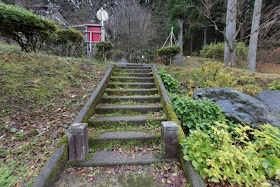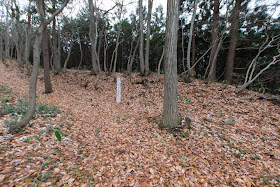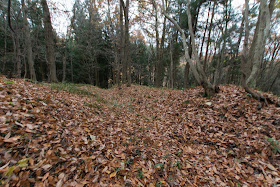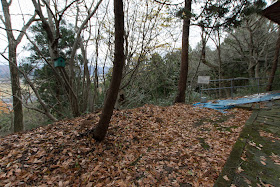Obasawa Castle
-Numerous dry moat defense line toward strong relative-
Overview
Name: Obasawa castle (Obasawa-jo)
Alias:
Place: Obasawa Murakami city, Niigata
Type: Mountain Castle
Built: 15th century
Remaining remnants: Clay walls and dry moats
Title:
Brief History
Obasawa Castle (大葉沢城) spreads over two hills named Miyayama and Terayama, which exists in line like a peninsular at 3 kilometer northeast of current Murakami city central. Castle site is at the north edge of huge Echigo plain, and a border area of flat area and Asahi mountains separated by Nagatsu-gawa river and Monzen-gawa river, both are tributaries of Miomote-gawa river.
Today at the south of Monzen-gawa river Murakami city area spreads, and contrary to this a vast rice field locates at the north of the river, toward main stream of Miomote-gawa river, where Obasawa castle belongs. Even today both area has different atmosphere in spite of same city, and 500 years ago both area were governed by different family of same ancestor.
Origin of Obasawa castle and Ayukawa clan
Precise year is unknown but Obasawa castle might be built by local lord Ayukawa clan in 15th century. The origin of Ayukawa clan is also unknown but it seems to be a branch family of Honjo clan, a strong local lord which was the lord of Honjo castle (later Murakami castle, Niigata prefecture) at Honjo castle.
It is expected Ayukawa clan was originally placed by Honjo clan to keep granary area at the upstream of Miomote-gawa river, and gradually grew their power based on rich rice production and turned to be a semi-independent lord of the area. It is also said Ayukawa clan was a family of Ashina clan which was the lord of Aizu basin of current Fukushima prefecture, but considering its location this is less probable.
Prior to the middle of 16th century, Ayukawa clan acted in cooperation with its main family Honjo clan, and fought with their enemies such as Uesugi clan, the governor of Echigo province (Niigata prefecture) or Date clan which was the lord of Yonezawa basin and attempted to step into the internal conflict of Echigo province.
Conflict with Honjo clan
However, in the middle of 16th century, Ayukawa clan broke with Honjo clan, for the conflict of a castle at the border of two clans. In 1539, Kiyonaga Ayukawa (?-?), the leader of Ayukawa clan, attacked Honjo castle with opponents of Honjo clan and Irobe clan then expelled Fusanaga Honjo (?-?), the leader of Honjo clan, from the castle.
Shigenaga Honjo (1540-1614), who was the son of Fusanaga Honjo, was a brave general and recovered the leader position of Honjo clan after growing up. Shigenaga Honjo and Kiyonaga Ayukawa followed to Kenshin Uesugi (1530-1578), the governor of Echigo province, and activated at the battles under Kenshin. But both clan had a potential conflict to each other.
Comparing Honjo clan and Ayukawa clan, as a main family Honjo clan was far stronger based on a larger territory and commercial interest at Murakami city or Iwafune port. Even though separated by several rivers the distance of Obasawa castle and Honjo castle was only three kilometer and there was a fear of sudden attack from Honjo clan to Obasawa castle.
Obasawa castle spreads only 70 meter height hill, but there was no other suitable mountain to built securer mountain castle in the territory of Ayukawa clan. Unfortunately at the south-west ward of Obasawa castle which is the direction of Honjo castle there was a higher hill and no view, thus it was necessary to prevent the attack of Honjo clan from this direction. To cope with this problem Obasawa clan might significantly improve the castle.
Structure of Obasawa castle
Core part of Obasawa castle spreads over Miya-yama hill. Between two large dry moat which separate the edge of the ridge, several terraces are built straightly along with the ridge. The highest point of the hill is a small terrace used as a ground of a shrine, but central area of the castle might be at large terrace at the east from hilltop.
The characteristic element of Obasawa castle is a numerous vertical dry moat covered south slope of Miya-yama hill. It was built to prevent horizontal movement of the enemy and keep them in straight line thus made the friend soldier easy to attack them. The moat of Obasawa castle has one of the highest density, along with Nagano castle (Fukuoka prefecture) or Ichihodani mountain castle (Fukui prefecture).
Terayama mountain might be a front fort and less secure but it was circled by clay wall and also had a combination of vertical dry moat at the edge. Two hills are connected by narrow ridge, which is secured by a line of clay wall. A large terraces at the side of the Tera-yama hill now used as the ground of the temple might be the ground of the residence of Ayukawa clan.
Loss of Obasawa castle
In 1568, Shigenaga Honjo at last raised his army against Kenshin Uesugi, for the dissatisfaction of reward for his achievement. Shigenaga asked Ayukawa clan and Irobe clan to support his rebel, but both clan declined and belonged to Kenshin. Kiyonaga Ayunaga might plan to reverse the situation between Ayukawa clan and Honjo clan utilizing the rebel of Shigenaga Honjo.
But furious Shigenaga Honjo attacked Obasawa castle and fell Obasawa caste as feared. Surprised Kenshin returned from the front and built Sasahira castle at the east mountain of Obasawa castle, to encircle Honjo castle. Ayukawa clan which lost their main base refused to Sasahira castle and seek for the recovery of Obasawa castle.
Against overwhelming army of Kenshin, Shigenaga well resisted at Honjo castle. But their ally Daihoji clan at Shonai area surrendered before the pressure of Kenshin, and isolated Honjo castle gradually lost its supply. Finally after nearly one year siege, Shigenaga finally surrendered to Kenshin but kept same status before the rebel.
Fall of Ayukawa clan and afterward of castle
As a result, Ayukawa clan failed to reverse the situation againt Honjo clan. Obasawa castle was returned to Ayukawa clan and tension with Honjo clan still continued. At the internal conflict of two adopted son of Kenshin, this time also Ayukawa clan supported to Kagetora Uesugi (1554-1579), contrary to Honjo clan belonged to Kagekatsu Uesugi (1556-1623),
Kagekatsu Uesugi became the winner of this internal conflict, then Shigenaga Honjo who activated at this conflict and succeeding rebel of Shigeie Shibata (1547-1587) became an important retainer of Kagekatsu. Later Shigenaga saved the crisis of Uesugi clan at the battle of Fukushima castle (Fukushima prefecture) against Date clan.
On the other hand, Morinaga Ayukawa (?-?), son of Kiyonaga Ayukawa, was once forgiven but was accused his neutral attitude for the rebel of Shigeie Shibata and lost his territory. Obasawa castle remained for the while, but might be abolished at the movement of Uesugi clan to Aizu basin in 1598.
Now no building remain but structure of the caste well remain over the hill. Especially numerous vertical dry hill keeps their shape mostly perfect, probably might be helped gentle slope. Structure and history of the castle shows thorough preparation of Ayukawa clan against Honjo clan and the braveness of Shigenaga Honjo overcame the preparation of Ayukawa clan.
Access
10 minutes drive from Nihonkai-Tohoku Jidoshado Expressway Asahi-Miomote interchange.
Related Castles
Murakami Castle -Northern fortress-
Nagano Castle -Hedgehog like castle with numerous dry moats-
Ichijodani Castle (1) -100 year prosperity of Asakura clan-
































































































































































































































































No comments:
Post a Comment